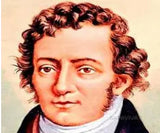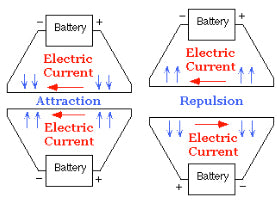|
Born January 20, 1775, Lyon France Died June 10, 1836, Marseille |
 |
Andre-Marie Ampere was born on 20 January 1775 to Jean-Jacques Ampere a prosperous businessman, and Jeanne Antoinette Desutieres-Sarcey Ampere, during the height of the French Enlightenment. He spent his childhood and adolescence at the family property at Poleymieux-au-Mont-d'Or near Lyon. Jean-Jacques Ampere, a successful merchant, was an admirer of the philosophy of Jean-Jacques Rousseau, whose theories of education were the basis of Ampere's education. Rousseau believed that young boys should avoid formal schooling and pursue instead an "education direct from nature." Ampere's father actualized this ideal by allowing his son to educate himself within the walls of his well-stocked library. In addition, Ampere used his access to the latest books to begin teaching himself advanced mathematics at age 12. In later life, Ampere claimed that he knew as much about mathematics and science when he was eighteen as ever he knew. However, his reading also embraced history, travels, poetry, philosophy, and the natural sciences. His mother was a devout woman, so Ampere was also initiated into the Catholic faith along with Enlightenment science.
The French Revolution (1789–99) that began during his youth was also influential. Ampere's father was called into public service by the new revolutionary government, becoming a justice of the peace in a small town near Lyon. When the Jacobin faction seized control of the Revolutionary government in 1792, his father Jean-Jacques Ampere resisted the new political tides, and he was guillotined on 24 November 1793, as part of the Jacobin purges of the period.
In 1799 Ampere took his first regular job as a mathematics teacher which gave him the financial security to marry his fiance Julie Carron.
As France moved into the Napoleonic regime at the turn of the century, Ampere found new successes in the studies of science and technologies and was appointed a professor of physics and chemistry at the Ecole Centrale in Bourg-en-Bresse.
After the death of his wife in 1803 Ampere moved to Paris and continued teaching and tutoring at the Ecole Polytechnique and was appointed a professor of mathematics in 1809. He also taught courses in philosophy and astronomy at the University of Paris. He continued in this line of work until 1820 when his close friend Francois Arago demonstrated to the French Academy of Sciences the discovery of Danish physicist Hans Christian Orsted that a magnetic needle is deflected by an adjacent electric current.
| Ampere began developing a mathematical and physical theory to understand the relationship between electricity and magnetism. Moving on from Orsted's experimental work, Ampere showed that two parallel wires carrying electric currents attract or repel each other, depending on whether the currents flow in the same or opposite directions, respectively - this laid the foundation of electrodynamics. | ||
|
||
| Ampere also applied this same principle to magnetism, showing the harmony between his law and French physicist Charles Augustin de Coulomb's law of magnetic action. Ampere's devotion to, and skill with, experimental techniques anchored his science within the emerging fields of experimental physics. |
In recognition of his contribution to the creation of modern electrical science, an international convention, signed at the 1881 International Exposition of Electricity, established the ampere as a standard unit of electrical measurement, along with the coulomb, volt, ohm, and watt, which are named, respectively, after Ampere's contemporaries Charles-Augustin de Coulomb of France, Alessandro Volta of Italy, Georg Ohm of Germany, and James Watt of Scotland. Ampère's name is one of the 72 names inscribed on the Eiffel Tower
Quote
“True greatness is when your name is like ampere, watt, and Fourier—when it's spelled with a lower case letter.”


